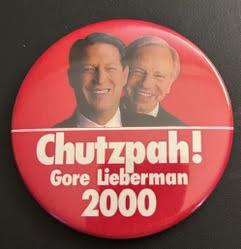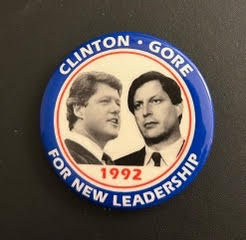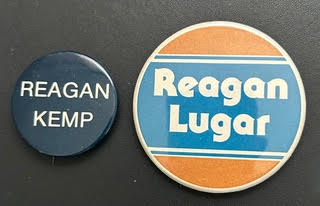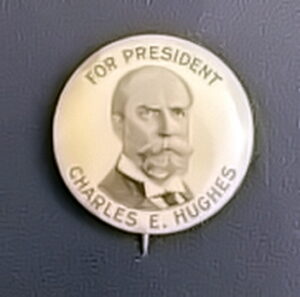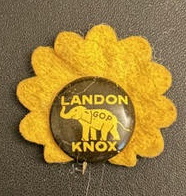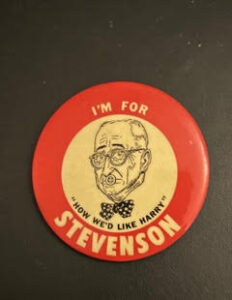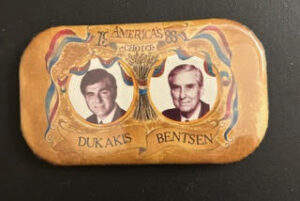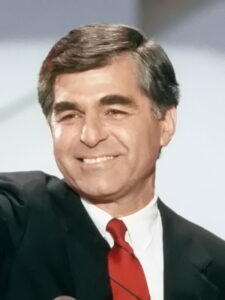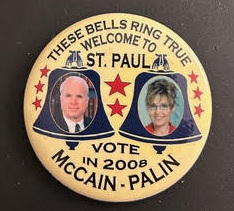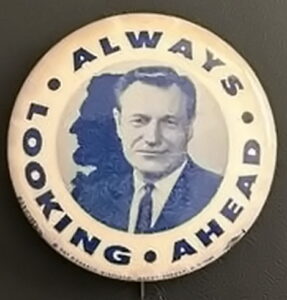Overview
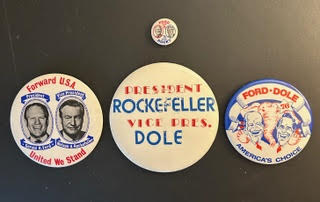
These pins display how divided the Republican Party was in 1976. In addition to running against future President Ronald Reagan for the Republican nomination, appointed President Gerald Ford had previously selected former NY Governor Nelson Rockefeller to be his Vice President. Many assumed that ‘Rocky’ would be Ford’s running mate in 1976. But people in Ford’s cabinet, notably his Chief of Staff Donald Rumsfeld, resented Rockefeller and convinced Ford to jettison him and pick the much more conservative Senator Bob Dole of Kansas as his running mate.
Ford and Dole ultimately lost in a squeaker to Jimmy Carter. Of interest is the middle button, possibly made by angry NY Republicans who were upset that Ford dropped their man from the ticket. It is the only button of its kind known to exist. The cartoon button is also somewhat of a rarity, having been made in Las Vegas and having significant value from the 1976 campaign.
This collection of campaign buttons provides a fascinating window into one of the most tumultuous periods in modern Republican Party history. Let me elaborate on the various layers of political drama and significance represented here.
The 1976 Republican Primary Battle
The 1976 Republican primary was one of the most contentious intra-party battles in modern American politics. Gerald Ford, despite being the sitting president, faced a formidable challenge from Ronald Reagan that went all the way to the convention floor. This was unprecedented. Sitting presidents typically face only token opposition for renomination. The Reagan challenge represented the growing conservative movement within the Republican Party that felt Ford was too moderate and too willing to work with Democrats.
Ford’s Unique Position as Appointed President
Gerald Ford’s situation was historically unique; he was the only person to serve as both Vice President and President without being elected to either office. He became VP when Spiro Agnew resigned in 1973, then President when Nixon resigned in 1974. This gave him less political capital than a traditionally elected president would have had, making him more vulnerable to primary challenges and internal party pressure.
The Nelson Rockefeller Factor
Nelson Rockefeller represented the liberal wing of the Republican Party – what was often called “Rockefeller Republicans.” His selection as VP in 1974 was seen as Ford’s attempt to maintain party unity and provide experienced leadership during the post-Watergate crisis. However, Rockefeller’s liberal positions on social issues and his support for big government programs made him a bit repugnant to the party’s growing conservative base.
Internal Palace Intrigue
The role of Donald Rumsfeld (then Ford’s Chief of Staff) in pushing Rockefeller off the ticket illustrates the behind-the-scenes power struggles within the Ford administration. Rumsfeld, along with other conservatives in Ford’s circle, saw Rockefeller as a political liability. Their successful campaign to remove him demonstrated the growing influence of conservative operatives within the Republican establishment.
The Bob Dole Selection
Choosing Bob Dole was Ford’s attempt to appease the conservative wing of the party while still maintaining some independence from Reagan. Dole was seen as a reliable conservative with strong debate skills who could attack the Democratic ticket while Ford stayed “presidential.” However, this strategy backfired somewhat, as Dole was seen as too harsh and partisan during the vice presidential debate.
The Narrow Loss to Carter
The Ford-Dole ticket’s narrow loss to Jimmy Carter (2 percentage points in the popular vote) has led to decades of speculation about whether different choices might have changed the outcome. Some argue that keeping Rockefeller might have helped in northeastern states, while others believe a more conservative choice might have energized the Republican base.
The Significance of These Specific Buttons
The Middle Button’s Rarity: The fact that this appears to be the only known example of this particular button makes it extraordinarily valuable to collectors. It likely represents New York Republicans’ genuine anger at Ford’s treatment of their former governor. Rockefeller had been a popular governor of New York for 15 years (1959-1973), and his dismissal would have been seen as a betrayal by many New York GOP activists.
The Las Vegas Cartoon Button: Political cartoon buttons from specific locations are often rare because they were produced in small quantities for local consumption. Las Vegas in 1976 was still a much smaller city than today, making locally produced political memorabilia particularly scarce.
Broader Historical Significance
These buttons collectively tell the story of the Republican Party’s evolution from the moderate, establishment-oriented party of the 1960s to the more conservative, populist-influenced party that would dominate American politics in the 1980s and beyond. The 1976 election was essentially the last hurrah for the Rockefeller wing of the Republican Party, and these buttons capture that transition in real time.
The internal GOP divisions shown here also foreshadowed the party’s future struggles between its establishment and insurgent wings, conflicts that would resurface in various forms through the Tea Party movement, the Trump presidency, and continue today.
Collector and Historical Value
These buttons are worth way more than just their price tag – they’re like little pieces of American history you can hold in your hand! Sure, they’re from one election, but they tell the story of how American politics was completely changing during the 1970s.
What makes them cool is that they show what regular people were feeling at the time. While official campaign ads and speeches gave you the polished version of events, these buttons capture the raw emotions – the excitement, the anger, the disappointment – of everyday Republicans who were watching their party tear itself apart.
That middle button being so rare makes it extra special. It’s not just a neat thing to own – it’s like having a piece of evidence that helps us solve the mystery of how politics works. We often think political change happens because of big, dramatic moments – famous speeches or major policy announcements. But the truth is, it’s usually lots of small decisions and local reactions (like some ticked-off New York Republicans making their protest button) that end up changing everything.
These little buttons help us understand that real political change doesn’t just come from the top down. It bubbles up from people in their local communities who get mad, get organized, and make their voices heard – even if it’s just through a homemade campaign button that somehow survives for nearly 50 years to tell their story.

